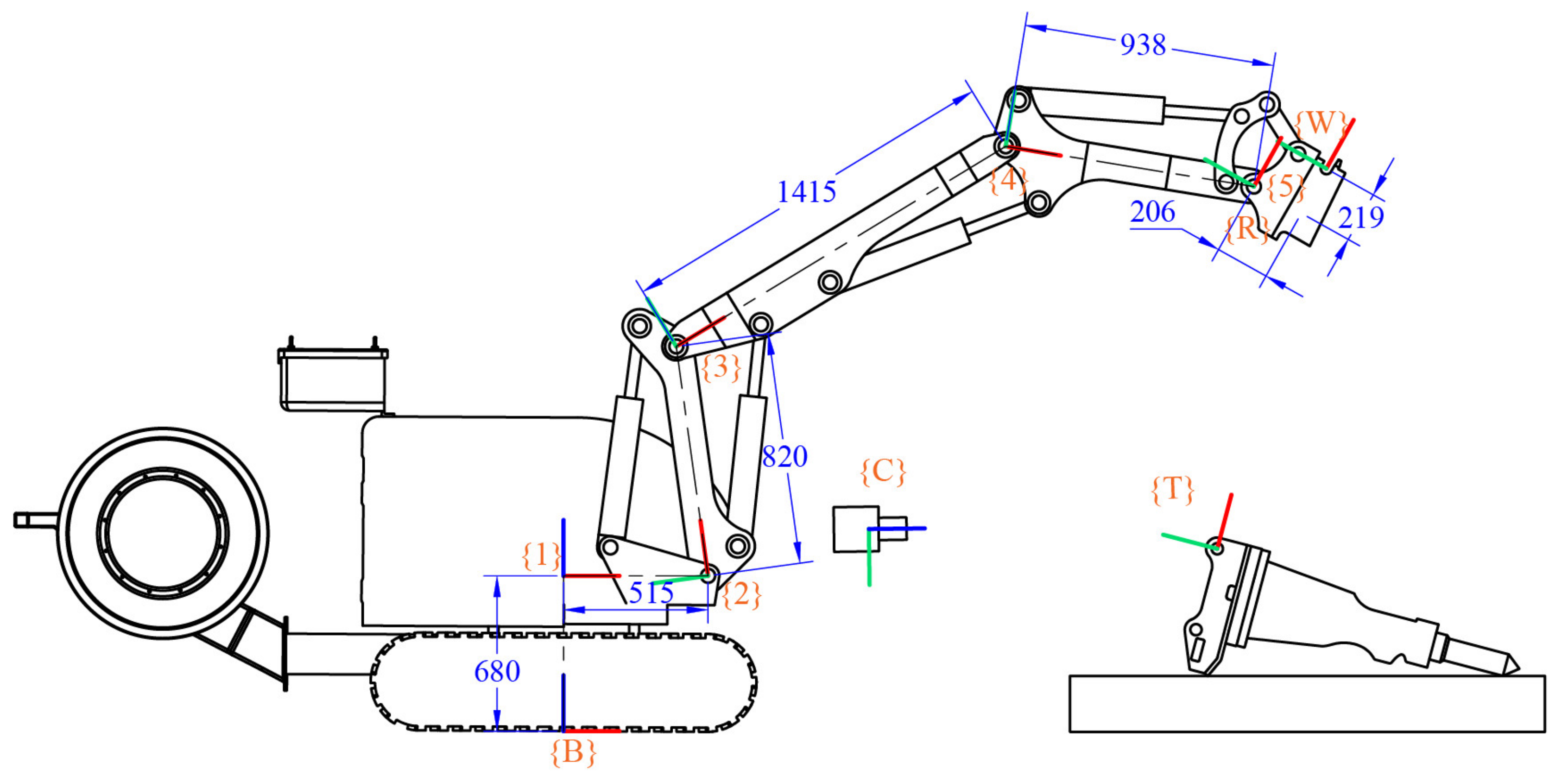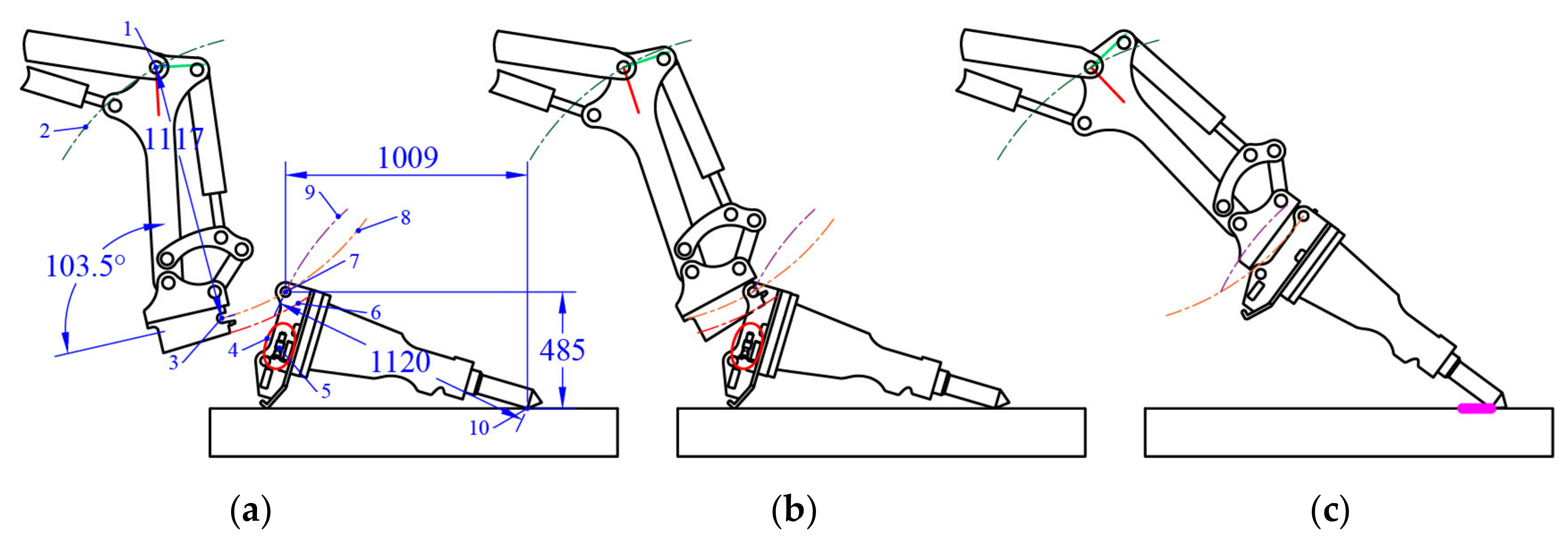Research on the Trajectory Planning of Demolition Robot Attachment Changing
Abstract
:1. Introduction
- The range of the relative distance between the robot base coordinate frame {B} and the attachment coordinate frame {T} is given, and the optimal distance interval is proposed.
- The optimal position of joint {4} is calculated, and the joint angles of the robot for attachment changing are solved through inverse kinematics.
- A method for changing the demolition robot attachment by single joint motion is proposed, and the distance error of trajectory between {W} and {T} is minimized.
2. Forward Kinematics of the Demolition Robot
3. Trajectory Planning of Attachment Changing
3.1. Position Determination of Joint {4}
| Algorithm 1 Calculate the optimal joint position of joint {4}. | |
| Inputs: Position and attitude of {T}, , , . Data of attachment, , , . | |
| Outputs: Position and attitude of {4}, , , . | |
| Notes:, , , . | |
| 1. | . |
| 2. | Calculate the trajectory of {T} according to Equation (9), and get , . |
| 3. | Calculate the collision region ellipse according to Equation (8), and get , . |
| 4. | Calculate the trajectory of {4} according to Equation (7), and get , . |
| 5. | for |
| 6. | , |
| 7 | , calculate , according to Equation (4) |
| 8. | |
| 9. | Calculate the trajectory of the quick-hitch equipment edge according to Equation (6), and get , . |
| 10. | . |
| 11. | if arc () is tangent to ellipse (), then |
| 12. | break |
| 13. | end if |
| 14. | end for |
| 15. | |
| 16. | , |
| 17. | |
| 18. | Output, , . |
3.2. Inverse Kinemics of Demolition Robot Attachment Changing
3.3. Position Determination of the Attachment Docking Coordinate Frame {T}
3.4. Process of Attachment Changing Trajectory Planning
4. Experiment
4.1. Experimental Conditions
4.2. Experimental Scene 1: Attachment Changing without Trajectory Planning
4.3. Experimental Scene 2: Attachment Changing with Trajectory Planning
4.4. Discussion
5. Conclusions
Supplementary Materials
Author Contributions
Funding
Acknowledgments
Conflicts of Interest
References
- Bogue, R. Robots in the nuclear industry: A review of technologies and applications. Ind. Robot Int. J. 2011, 38, 113–118. [Google Scholar] [CrossRef]
- Delmerico, J.; Mintchev, S.; Giusti, A.; Gromov, B.; Melo, K.; Horvat, T.; Cadena, C.; Hutter, M.; Ijspeert, A.; Floreano, D.; et al. The current state and future outlook of rescue robotics. J. Field Robot. 2019, 36, 1171–1191. [Google Scholar] [CrossRef]
- Omata, T.; Ishibashi, H.; Tomita, K. Development of Double Arm Working Machine for Demolition and Scrap Processing. In Proceedings of the International Symposium on Automation & Robotics in Construction, Seoul, Korea, 29 June–2 July 2011. [Google Scholar]
- Kawatsuma, S.; Mimura, R.; Asama, H. Unitization for portability of emergency response surveillance robot system: Experiences and lessons learned from the deployment of the JAEA-3 emergency response robot at the Fukushima Daiichi Nuclear Power Plants. Robomech J. 2017, 4. [Google Scholar] [CrossRef] [Green Version]
- Buckingham, R. Nuclear snake-arm robots. Ind. Robot Int. J. 2012, 39, 6–11. [Google Scholar] [CrossRef]
- Burrell, T.; Montazeri, A.; Monk, S.; Taylor, C.J. Feedback Control—Based Inverse Kinematics Solvers for a Nuclear Decommissioning Robot. IFAC Pap. 2016, 49, 177–184. [Google Scholar] [CrossRef] [Green Version]
- Corucci, F.; Ruffaldi, E. Toward Autonomous Robots for Demolitions in Unstructured Environments; Springer: Cham, Switzerland, 2015; pp. 1515–1532. [Google Scholar]
- Brokk Global. Available online: https://www.brokk.com (accessed on 21 July 2020).
- Giant I-Equipment. Available online: http://www.giantchina.com (accessed on 21 July 2020).
- Cieślak, M.; Derlukiewicz, D. Determining the causes of the arm member fractures of the brokk 90 demolition machine with use of high speed camera and finite element method. In Proceedings of the 8-th International Symposium on Mechanics of Materials & Structures, Augustow, Poland, 31 May–3 June 2015. [Google Scholar]
- Derlukiewicz, D.; Ptak, M.; Wilhelm, J.; Jakubowski, K. The Numerical-Experimental Studies of Demolition Machine Operator Work. In Proceedings of the International Conference on Renewable Energy Sources-Research & Business, Wrocław, Poland, 22–24 June 2016. [Google Scholar]
- Derlukiewicz, D. Application of a Design and Construction Method Based on a Study of User Needs in the Prevention of Accidents Involving Operators of Demolition Robots. Appl. Sci. 2019, 9, 1500. [Google Scholar] [CrossRef] [Green Version]
- Taylor, C.J.; Chotai, A.; Robertson, D. State dependent control of a robotic manipulator used for nuclear decommissioning activities. In Proceedings of the 2010 IEEE/RSJ International Conference on Intelligent Robots and Systems, Taipei, Taiwan, 18–22 October 2010; pp. 2413–2418. [Google Scholar]
- Assenov, E.; Bosilkov, E.; Dimitrov, R.; Damianov, T. Kinematics and dynamics of working mechanism of hydraulic excavator. Annu. Univ. Min. Geol. 2003, 46, 47–49. [Google Scholar]
- Fujino, K.; Moteki, M.; Nishiyama, A.; Yuta, S. Towards Autonomous Excavation by Hydraulic Excavator—Measurement and Consideration on Bucket Posture and Body Stress in Digging Works. In Proceedings of the 2013 IEEE Workshop on Advanced Robotics and Its Social Impacts, Tokyo, Japan, 7–9 November 2013; pp. 231–236. [Google Scholar]
- Chang, P.H.; Lee, S.-J. A straight-line motion tracking control of hydraulic excavator system. Mechatronics 2002, 12, 119–138. [Google Scholar] [CrossRef]
- Denavit, J.; Hartenberg, R.S. Notation for lower-pair mechanisms based on matrices. J. Appl. Mech. 1995, 22, 215–221. [Google Scholar]
- Besset, P.; Taylor, C.J. Inverse kinematics for a redundant robotic manipulator used for nuclear decommissioning. In Proceedings of the 2014 UKACC International Conference on Control (CONTROL), Loughborough, UK, 9–11 July 2014; pp. 56–61. [Google Scholar]
- Brommer, C.; Malyuta, D.; Hentzen, D.; Brockers, R. Long-Duration Autonomy for Small Rotorcraft UAS Including Recharging. In Proceedings of the 2018 IEEE/RSJ International Conference on Intelligent Robots and Systems, Madrid, Spain, 1–5 October 2018; pp. 7252–7258. [Google Scholar]
- Olson, E. AprilTag: A Robust and Flexible Visual Fiducial System. In Proceedings of the 2011 IEEE International Conference on Robotics and Automation, Shanghai, China, 9–13 May 2011. [Google Scholar]
- Wang, J.; Olson, E. AprilTag 2: Efficient and Robust Fiducial Detection. In Proceedings of the 2016 IEEE/RSJ International Conference on Intelligent Robots and Systems, Daejeon, Korea, 9–14 October 2016. [Google Scholar]
- Maximilian, K.; Acshi, H.; Edwin, O. Flexible Layouts for Fiducial Tags. In Proceedings of the IEEE/RSJ International Conference on Intelligent Robots and Systems (IROS), Las Vegas, NV, USA, 25–29 October 2020. [Google Scholar]
- Deng, Q.; Zou, S.; Chen, H.; Duan, W. Research on Visualization and Error Compensation of Demolition Robot Attachment Changing. Sensors (Basel Switzerland) 2020, 20, 2428. [Google Scholar] [CrossRef] [PubMed]
- Duan, W.; Zou, S.; Ren, Y.; Deng, Q. Research on Trajectory Planning of Multi-function Demolition Robot Automatic Docking Tool. J. Univ. South China (Sci. Technol.) 2019, 33, 77–83. [Google Scholar] [CrossRef]
- Guo, C.; Xu, C.; Hao, J.; Xiao, D.; Yang, W. Ultrasonic Non-Destructive Testing System of Semi-Enclosed Workpiece with Dual-Robot Testing System. Sensors 2019, 19, 3359. [Google Scholar] [CrossRef] [PubMed] [Green Version]
- Pardi, T.; Ortenzi, V.; Fairbairn, C.; Pipe, T.; Esfahani, A.M.G.; Stolkin, R. Planning Maximum-Manipulability Cutting Paths. IEEE Robot. Autom. Lett. 2020, 5, 1999–2006. [Google Scholar] [CrossRef]
- Chen, D.; Li, S.; Wu, Q. A Novel Supertwisting Zeroing Neural Network With Application to Mobile Robot Manipulators. IEEE Trans. Neural Netw. Learn. Syst. 2020. [Google Scholar] [CrossRef] [PubMed]
- Dai, C.; Lefebvre, S.; Yu, K.-M.; Geraedts, J.M.P.; Wang, C.C. Planning Jerk-Optimized Trajectory with Discrete-Time Constraints for Redundant Robots. arXiv 2019, arXiv:1909.06570. Available online: https://arxiv.org/abs/1909.06570 (accessed on 21 July 2020). [CrossRef] [Green Version]
- John, C. Introduction to Robotics: Mechanics and Control, 4th ed.; Pearson: London, UK, 2017. [Google Scholar]
- Peter, C. Robotics, Vision & Control; Springer: Berlin/Heidelberg, Germany, 2017. [Google Scholar]











| Joint i | θi | di | αi | ai |
|---|---|---|---|---|
| 1 | θ1 | 0 | 0 | 0.68 m |
| 2 | θ2 | 0 | 90° | 0.515 m |
| 3 | θ3 | 0 | 0 | 0.82 m |
| 4 | θ4 | 0 | 0 | 1.415 m |
| 5 | θ5 | 0 | 0 | 0.938 m |
| Docking Point | Position | RZ4 | Distance Error |
|---|---|---|---|
| Docking Point 1 | (−0.864 m, 0, 0.709 m) | −70.9° | 0.017 m |
| Docking Point 2 | (−0.717 m, 0, 0.857 m) | −81.6° | 0.064 m |
| Docking Point 3 | (−0.557 m, 0, 0.969 m) | −91.6° | 0.134 m |
| Docking Point 4 | (−0.380 m, 0, 1.051 m) | −101.6° | 0.237 m |
| Docking Point 5 | (−0.192 m, 0, 1.101 m) | −111.6° | 0.377 m |
| Attachment Changing Stage | Without Trajectory Planning | Trajectory Planning |
|---|---|---|
| Initialization | 150 s | 60 s |
| Preparation | 55 s | 65 s |
| Range Alignment | 30 s | 5 s |
| Angle Alignment | 15 s | 5 s |
| Total Time | 250 s | 135 s |
© 2020 by the authors. Licensee MDPI, Basel, Switzerland. This article is an open access article distributed under the terms and conditions of the Creative Commons Attribution (CC BY) license (http://creativecommons.org/licenses/by/4.0/).
Share and Cite
Deng, Q.; Zou, S.; Chen, H.; Duan, W. Research on the Trajectory Planning of Demolition Robot Attachment Changing. Sensors 2020, 20, 4502. https://doi.org/10.3390/s20164502
Deng Q, Zou S, Chen H, Duan W. Research on the Trajectory Planning of Demolition Robot Attachment Changing. Sensors. 2020; 20(16):4502. https://doi.org/10.3390/s20164502
Chicago/Turabian StyleDeng, Qian, Shuliang Zou, Hongbin Chen, and Weixiong Duan. 2020. "Research on the Trajectory Planning of Demolition Robot Attachment Changing" Sensors 20, no. 16: 4502. https://doi.org/10.3390/s20164502





